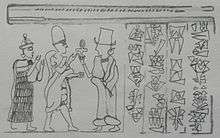Yarim-Lim II
| Yarim-Lim II | |
|---|---|
| Great King of Yamhad | |
 | |
| Reign | c. 1720 BC – c. 1700 BC. Middle chronology |
| Predecessor | Abba-El I |
| Successor | Niqmi-Epuh |
Yarim-Lim II (reigned c. 1720 BC – c. 1700 BC - Middle chronology ) was the king of Yamhad (Halab) succeeding his father Abba-El I
Reign
Little of Aleppo has been excavated by archaeologists and knowledge about yamhad and its kings mainly comes from tablets discovered at Alalakh and Mari,[1] little is known about Yarim-Lim II, his existence is confirmed by a seal inscription discovered at Alalakh where he designates himself as son of Abba-El I and "beloved of the god Hadad",[2][3] one of his ministers is Ini-Kubaba, known from his seal inscription found in Alalakh.[4]
Identity
the identity of this king is under dispute, Abba-El I had a brother called Yarim-Lim whom he gave the kingdom of Alalakh,[5] the king of Alalakh mentions that he is the son of Hammurabi I and Yarim-Lim II in his seal inscription mentions that he is the son of Abba-El I,[6] however Moshe Weinfeld suggest that Yarim-Lim II of Yamhad is the same Yarim-Lim of Alalakh, he believes that the seal which mentions that Yarim-Lim was a son of Abba-El belong to Yarim-Lim son of Hammurab I, and that the reason for mentioning that Yarim-Lim is the son of Abba-El I in the seal inscription is that Abba-El adopted his brother in order to create the legal base for installing him as king.
This theory is hard to proof as there is no textual reference to any adoption and the fact that Yarim-lim (son of Hammurabi) installation on the throne of Alalakh happened long before the assumed adoption took place beside, there is no need for an adoption to legitimize the grant of Alalakh to the king brother.[7]
Death and Ancestors
Yarim-Lim II died ca. 1700 BC and was succeeded by his son Niqmi-Epuh
| Ancestors of Yarim-Lim II | ||||||||||||||||||||||||||||||||||||||||||||||||||||||||||||||||||||||||||||||||||||||||||||||||||||||||||||||||||||||||||||||||||||||||||||||||||||||||||||||||
|---|---|---|---|---|---|---|---|---|---|---|---|---|---|---|---|---|---|---|---|---|---|---|---|---|---|---|---|---|---|---|---|---|---|---|---|---|---|---|---|---|---|---|---|---|---|---|---|---|---|---|---|---|---|---|---|---|---|---|---|---|---|---|---|---|---|---|---|---|---|---|---|---|---|---|---|---|---|---|---|---|---|---|---|---|---|---|---|---|---|---|---|---|---|---|---|---|---|---|---|---|---|---|---|---|---|---|---|---|---|---|---|---|---|---|---|---|---|---|---|---|---|---|---|---|---|---|---|---|---|---|---|---|---|---|---|---|---|---|---|---|---|---|---|---|---|---|---|---|---|---|---|---|---|---|---|---|---|---|---|---|
| ||||||||||||||||||||||||||||||||||||||||||||||||||||||||||||||||||||||||||||||||||||||||||||||||||||||||||||||||||||||||||||||||||||||||||||||||||||||||||||||||
| King Yarim-Lim II of Yamhad (Halab) Died: 1700 BC | ||
| Regnal titles | ||
|---|---|---|
| Preceded by Abba-El I |
Great King of Yamhad 1720 – 1700 BC |
Succeeded by Niqmi-Epuh |
References
Citations
- ↑ prof : Ahmad Arhim Hebbo. History of Ancient Levant (part 1) Syria.
- ↑ Horst Klengel. Syria, 3000 to 300 B.C. p. 62.
- ↑ Beatrice Teissier. Egyptian Iconography on Syro-Palestinian Cylinder Seals of the Middle Bronze Age. p. 27.
- ↑ Douglas Frayne. Old Babylonian Period (2003-1595 BC). p. 789.
- ↑ William J. Hamblin. Warfare in the Ancient Near East to 1600 BC. p. 264.
- ↑ Jimmy Jack McBee Roberts. The Bible and the Ancient Near East: Collected Essays. p. 149.
- ↑ Jimmy Jack McBee Roberts. The Bible and the Ancient Near East: Collected Essays. p. 150.